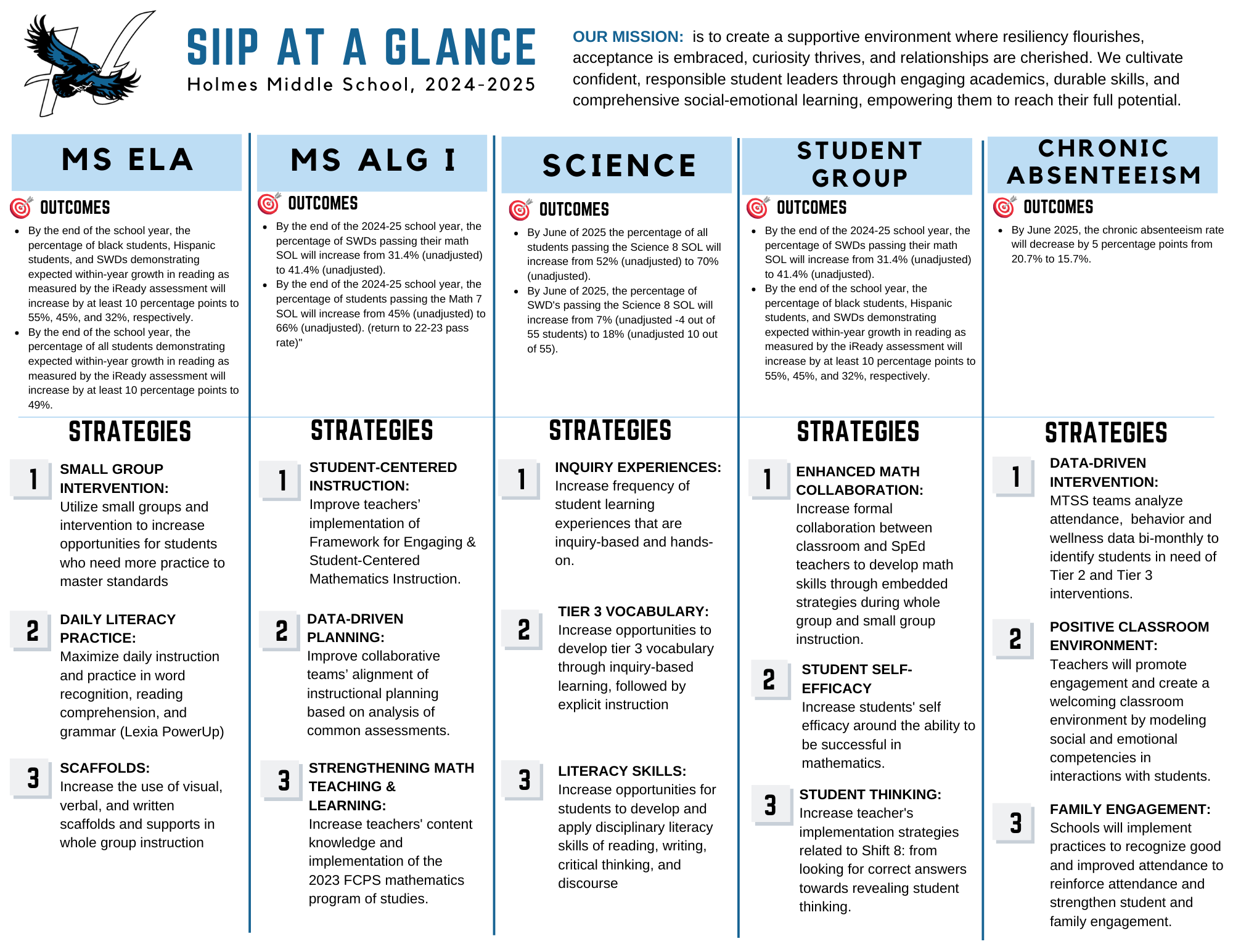School Innovation and Improvement Plan
An at-a-glance look at outcome goals for this academic school year
School Innovation & Improvement Plan Plan At-a-Glance
- 2024 - 2025
- Holmes Middle School
- Region 6
- Serena Giron, Principal Holmes MS
Background: All Fairfax County schools are also required to complete an access and opportunity goal as part of their School Innovation and Improvement Plan (SIIP) and can also capture additional goals.

Click here to view SIIP At-A-Glance as a PDF:SIIP At A Glance- Holmes MS .pdf
English Language Arts:
Outcomes:
- By the end of the school year, the percentage of black students, Hispanic students, and SWDs demonstrating expected within-year growth in reading as measured by the iReady assessment will increase by at least 10 percentage points to 55%, 45%, and 32%, respectively.
- By the end of the school year, the percentage of all students demonstrating expected within-year growth in reading as measured by the iReady assessment will increase by at least 10 percentage points to 49%
Strategies:
- Utilize small groups and intervention to increase opportunities for students who need more practice to master standards
- Maximize daily instruction and practice in word recognition, reading comprehension, and grammar (Lexia PowerUp)
- Increase the use of visual, verbal, and written scaffolds and supports in whole group instruction
Success in Algebra before High School
Outcomes:
- By the end of the 2024-25 school year, the percentage of SWDs passing their math SOL will increase from 31.4% (unadjusted) to 41.4% (unadjusted).
- By the end of the 2024-25 school year, the percentage of students passing the Math 7 SOL will increase from 45% (unadjusted) to 66% (unadjusted). (return to 22-23 pass rate).
Strategies:
- Improve teachers’ implementation of Framework for Engaging & Student-Centered Mathematics Instruction.
- Improve collaborative teams’ alignment of instructional planning based on analysis of common assessments.
- Increase teachers' content knowledge and implementation of the 2023 FCPS mathematics program of studies.
Student Group:
Outcomes:
- By the end of the 2024-25 school year, the percentage of SWDs passing their math SOL will increase from 31.4% (unadjusted) to 41.4% (unadjusted).
- By the end of the school year, the percentage of black students, Hispanic students, and SWDs demonstrating expected within-year growth in reading as measured by the iReady assessment will increase by at least 10 percentage points to 55%, 45%, and 32%, respectively.
Strategies:
- Increase formal collaboration between classroom teachers and SpEd teachers to develop math skills through the use of embedded strategies during whole group and small group instruction.
- Increase students' self efficacy around the ability to be successful in mathematics.
- Increase teacher's implementation strategies related to Shift 8: from looking for correct answers towards revealing student thinking.
- Utilize data from Lexia (PowerUp) to facilitate small group learning opportunities
- Increase opportunities to explicitly teach vocabulary using evidence-based methods (i.e. semantic feature analysis, analyzing word parts, Frayer model, defining words in context, semantic mapping, etc.)
- Use multiple data points and evidence-based interventions aligned to science based reading research literacy intervention in Tier 2 and Tier 3.
Science:
Outcomes:
- By June of 2025 the percentage of all students passing the Science 8 SOL will increase from 52% (unadjusted) to 70% (unadjusted).
- By June of 2025, the percentage of SWD's passing the Science 8 SOL will increase from 7% (unadjusted -4 out of 55 students) to 18% (unadjusted 10 out of 55).
Strategies:
- Increase frequency of student learning experiences that are inquiry-based and hands-on.
- Increase opportunities to develop tier 3 vocabulary through inquiry-based learning, followed by explicit instruction.
- Increase opportunities for students to develop and apply disciplinary literacy skills of reading, writing, critical thinking, and discourse.
Chronic Absenteeism:
Outcome:
By June 2025, the chronic absenteeism rate will decrease by 5 percentage points from 20.7% to 15.7%.
Strategies:
- MTSS Schoolwide and Site Intervention teams analyze attendance along with behavior and wellness data bi-monthly to identify students in need of Tier 2 and Tier 3 interventions.
- Teachers will promote student engagement and create a welcoming classroom environment by modeling social and emotional competencies in their interactions with students.
- Schools will implement practices to recognize good and improved attendance to reinforce attendance and strengthen student and family engagement.
Portrait of a Graduate:
Outcome:
- By May 31, 2025, all students at Holmes, will have chosen an ATL skill and reflected at least once on their growth with a piece of evidence.
Strategies:
- Select a POG skill from the vertical articulation charts (Resource 1) to focus on with students and explicitly teach the skill; if at an IB school, select an ATL skill from the IB & POG Crosswalk (Resource 2) to focus on with students and explicitly teach the skill.
- Dedicate time for regular student reflection (Resource 1; Resource 2 for IB Schools) - such as turn and talks, quick writes, or silent thinking to self - to process the POG/ATL skills they utilized during meaningful learning experiences and consider how they can continue to grow.
- Utilize POG Reflection Cards (Resource 1) and Sentence Strips for Reflection (Resource 2) to create opportunities for students to reflect on growth in POG skills; if at an IB school, utilize ATL Reflection Cards and ATL Sentence Strips for Reflection (Resource 3).

